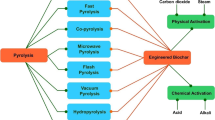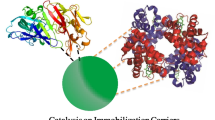Abstract
Fusarium solani pisi recombinant cutinase, immobilized by entrapment in calcium alginate and by covalent binding on porous silica, was used to catalyze the hydrolysis of tricaprylin. The influence of relevant parameters on the catalytic activity such as pH, temperature, and the substrate concentration were studied. Cutinase immobilized by entrapment presented a Michaelis-Menten kinetics for tricaprylin concentrations up to 200 mM. At higher concentrations of substrate, inhibition was observed. For covalent binding immobilization, diffusional limitations were observed at low substrate concentrations and substrate inhibition occurred for concentrations higher than 150 mM. The stability of immobilized cutinase was also evaluated. The enzyme immobilized by entrapment showed a high stability, in contrast to the immobilization on porous silica.
Similar content being viewed by others
References
Goldberg, M. (1989), PhD thesis, Université de Compiegne, Compiegne, France.
Klibanov, A. M. (1979),Anal. Biochem. 93, 1–25.
Tanaka, A. and Kawamoto, T. (1991), inProtein Immobilization, Taylor, R. F., ed., Marcel Dekker Inc., New York, pp. 183–208.
Lauwereys, M., De Geus, P., De Meutter, J., Staussens, P., and Matthysseus, G. (1991), inLipases: Structure, Mechanism and Genetic Engineering, vol. 16, Alberghina, L., Schmid, R. D., Verger, R. eds. VCH, Weinheim, pp. 243–251.
Henley, J. P. and Sadana, A. (1985),Enzyme Microb. Technol. 7, 50–60.
Hertzberg, S., Kvittingen, L., Anthonsen, T., and Skjak-Broek, G. (1992),Enzyme Microb. Technol. 14, 42–47.
Weetall, H. H., Vann, W. P., Pitcher, W. H., Lee, D. D., Lee, Y. Y., and Tsao, G. T., (1976), inMethods in Enzymology, vol. 44, Mosbach, K., ed., Academic, New York, pp. 139–140.
Lowry, O. H., Rosenbrough, N. J., Farr, L., and Randall, R. J., (1951),J. Biol. Chem. 193, 265–275.
Lowry, R. R. and Tinsley, I. J. (1976),J. Am. Oil Chem. Soc. 53, 470–472.
Melo, E. P., Aires-Barros, M. R., and Cabrai, J. M. S. (1995),Appl. Biochem. Biotechn. 50, 45–56.
Martinek, K., Klibanov, A. M, Goldmacher, V. S., and Berezin, I. V. (1977),Biochem. Biophys. Acta. 485, 1–12.
Cornish-Bowden, A. and Wharton, C. W. (1988), inEnzyme Kinetics, Rickwood, D., Male, D., eds., Irl, Oxford.
Gray, C. J. (1988),Biocatalysis 1, 187–196.
Monsan, P. and Combes, D. (1988),Ann. N. Y. Acad. Sci. 9, 48–60.
Author information
Authors and Affiliations
Rights and permissions
About this article
Cite this article
Gonçalves, A.P.V., Cabral, J.M.S. & Aires-Barros, M.R. Immobilization of a recombinant cutinase by entrapment and by covalent binding. Appl Biochem Biotechnol 60, 217–228 (1996). https://doi.org/10.1007/BF02783585
Received:
Accepted:
Issue Date:
DOI: https://doi.org/10.1007/BF02783585




